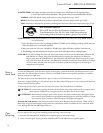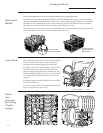
12
Using the dishwasher
Dishwasher
Detergents
Use only detergent specifically made for use
in dishwashers. Keep your detergent fresh
and dry. Don’t put powder detergent into the
dispenser until you’re ready to wash dishes.
The amount of detergent to use depends on
whether your water is hard or soft. With hard
water, you need extra detergent. With soft
water, you need less detergent.
Protect your dishes and dishwasher by
contacting your water department and asking
how hard your water is. Twelve or more
grains
is extremely hard water. A water softener is
recommended.
Without it, lime can build up
in the water valve, which could stick while open
and cause flooding. Too much detergent with
soft water can cause a permanent cloudiness of
glassware, called etching.
To open the detergent compartment, push the
lever latch inward.
You’ll find two detergent dispensers on the
inside door of your dishwasher. All wash cycles
require detergent in the main cup. Some wash
cycles require the use of the open cup. When
using automatic dishwashing detergent tabs,
place one tab in the main cup and close.
Be sure the Cycle Status Indicators (on some
models) are not lit before adding detergent.
Otherwise, the detergent cup will not close and
latch properly. Add detergent then close the
main cup.
NOTE: To open detergent cup after it has been
closed, push the lever latch inward.
Water
Temperature
The entering water must be at least 120°F. and
not more than 150°F., for effective cleaning and
to prevent dish damage. Check the water
temperature with a candy or meat thermometer.
Turn on the hot water faucet nearest the
dishwasher, place the thermometer in a glass
and let the water run continuously into the
glass until the temperature stops rising.
Use a
Rinse
Agent
A rinse agent improves dry performance,
removes spots and prevents new film build-up
on your dishes, glasses, flatware, cookware
and plastic.
Fill the rinse agent chamber by rotating the
round cap counterclockwise and remove. Fill
chamber to maximum level. Replace and lock
the cap into place.
To check if rinse agent is needed: a solid black
indicator indicates sufficient rinse agent; a clear
indicator indicates a low level and requires
adding more rinse agent.
• A full dispenser should last about one month.
• If rinse agent spills, wipe it up immediately.
It can keep your detergent from working.
•
If after washing you notice cloudy spots, streaks
or water marks on the glassware, and the rinse
agent dispenser is not empty, it may be
necessary to increase the dispenser settings. To
do so, remove the cap and using a butter knife,
rotate the indicator arrow to a higher number.
Replace the cap when done.
•
If glasses appear smeared or there is foam
present on the bottom of the glasses or the
bottom of the machine, select a lower dosage
number.
1
2
3
4
5
6
1
2
3
4
5
6
M
X
A
Lever
Main compartment
Open
cup
Light level Indicator
Adjust to higher or lower number


















